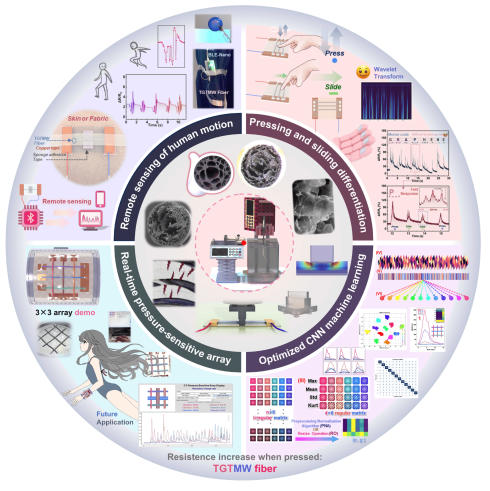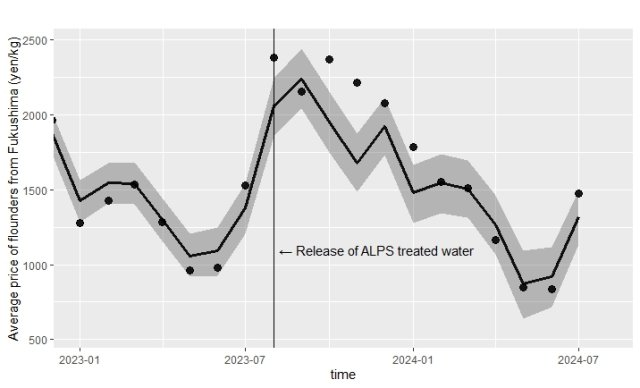Reinventing Fiber-Based Pressure Sensors
- Share
- Tweet
- Send to email
Researchers develop fibers with a unique internal structure that enables highly accurate and sensitive pressure sensing
Pressure sensors are crucial in many emerging applications, but traditional designs are often bulky or inflexible. In a recent study, researchers from Japan developed a fiber-shaped pressure sensor that overcomes this limitation by increasing—rather than decreasing—its resistance when compressed. Owing to a unique multi-walled conductive core made from graphene nanoplatelets, these fibers could enable fine-tuned tactile sensing for next-generation smart textiles and robotic grippers.
Image title: Properties and potential applications of TGTMW (TiO₂/graphene/thermoplastic polyurethane multi-wall) fibers
Image caption: TGTMW fibers display a unique increase in resistance in response to pressure changes, which makes these innovative fibers a promising candidate for application as flexible pressure sensors in a wide variety of fields, including gesture-based control, robotic grippers, smart textiles, and medical care.
Image credit: Dr. Chunhong Zhu from Shinshu University, Japan
Image source: NA
License type: Original content
Usage restrictions: Credit must be given to the creator
The need for pressure sensors has been steadily increasing across diverse applications, from robotic grippers that need accurate tactile feedback to wearable devices that monitor human movement. Ideally, to be effectively integrated into prosthetic limbs, smart textiles, or robots, pressure sensors need to be flexible, sensitive, and durable. However, traditional film-based and aerogel-based sensors are often too large and rigid, hindering their adoption in many fields.
These limitations have motivated research into fiber-based pressure sensors, which could offer enhanced versatility and miniaturization. A major hurdle that remains is the design of a sensing mechanism that works efficiently given a fiber’s series circuit structure. In a conductive fiber, a local decrease in resistance, which is the common response for most pressure sensors, has a small impact on the fiber’s overall conductivity. To be truly effective, a fiber pressure sensor needs to exhibit the opposite behavior: a substantial increase in overall resistance when compressed.
Now, a research team including Dr. Ziwei Chen, from Shinshu University, Japan, and led by Associate Professor Chunhong Zhu also from Shinshu University, Japan, has overcome this challenge through an innovative approach to fiber design. Their study was published online in the journal Advanced Materials on July 16, 2025. The researchers developed a unique multi-walled fiber exhibiting a unique mechanism that modulates resistivity under pressure, addressing a fundamental problem in fiber-based pressure sensors.
The new fibers were prepared via a coaxial wet-spinning process, producing a smooth outer shell of thermoplastic polyurethane (TPU) and titanium dioxide (TiO₂) and a core containing 2D graphene nanoplatelets (GNPs). By leveraging the van der Waals interactions and self-stacking behavior of these flat GNPs, the fiber core adopted a multi-wall structure that was critical to their function. Thus, the team named their creation ‘TGTMW fibers’ (TiO₂/graphene/thermoplastic polyurethane multi-wall fibers).
Through extensive structural analysis and experimentation, the researchers showed that when a portion of a TGTMW fiber is compressed, the internal multi-wall structure bends and develops microcracks. These microcracks disrupt the conductive pathways of the axially aligned GNPs, causing a sharp increase in the fiber’s electrical resistance. This mechanism allows the TGTMW fiber to produce a highly responsive signal even when only a small section is compressed. To put this into perspective, a sensor using a TGTMW fiber is sensitive enough to detect a light fingertip touch with a minimum pressure of only 0.1 N.
Notably, the high aspect ratio of the TGTMW fibers makes them ideal for applications that require fine-grained tactile feedback. For instance, in soft robotics, these fibers could be integrated into the fingertips of robotic grippers used for elderly care or medical assistance. “Most available tactile sensors used on robotic hands are rigid, which poses the risk of causing discomfort or even injury during contact with humans. In contrast, fiber-shaped flexible pressure sensors offer both comfort and compliance, reducing the risk of harm,” remarks Dr. Zhu.
Furthermore, TGTMW fibers can be used to distinguish between different types of tactile events. The researchers showed that by using wavelet transforms on data from a three-fiber array, they could accurately differentiate between various forms of presses and slides. “This capability is particularly valuable for the tactile sensing of frictional states, enabling robotic systems to distinguish between static and dynamic friction—much like human fingertips do—potentially allowing robotic manipulation to become as nuanced and dexterous as that of humans,” highlights Dr. Zhu.
The scalability of the TGTMW fibers also opens the door to novel designs in smart textiles and interactive surfaces. Systems capable of gesture detection could be embedded into specialized garments for human-machine interaction in challenging environments where touchscreens are impractical, such as underwater or in space.
Looking ahead, the researchers believe this work represents a foundational shift in tactile sensors. “To put it boldly, our work could be seen as the beginning of a new subfield—introducing a distinct fiber-based pressure sensor architecture and offering a working prototype with solid performance,” concludes Zhu. “The proposed TGTMW fiber, with its innovative design, distinct structure, and versatile applications, holds immense potential for advancing flexible sensors and next-generation smart devices.”
|
Reference |
||
|
Title of original paper: |
Fibrous Pressure Sensor with Unique Resistance Increase under Partial Compression: Coaxial Wet-Spun TiO2/Graphene/Thermoplastic Polyurethane Multi-Wall Multifunctional Fiber |
|
|
Journal: |
Advanced Materials |
|
|
DOI: |
||






